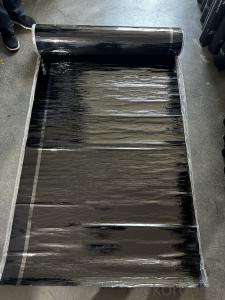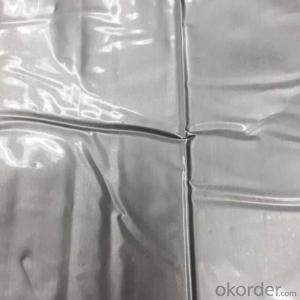Strong cross-membrane reaction type self-adhesive waterproof membrane
- Loading Port:
- China main port
- Payment Terms:
- TT OR LC
- Min Order Qty:
- 10 m²
- Supply Capability:
- 80000 m²/month
OKorder Service Pledge
OKorder Financial Service
You Might Also Like
Specification
01 Product introduction Product Introduction
Strong cross-film reactive self-adhesive waterproof coil is a kind of high performance, cold construction reactive bond waterproof coil made of special cross-layer high density polyethylene (HDPE) strong film and high quality polymer reactive binder by special process composite. It has super bonding performance with concrete, high porosity sealing, excellent dimensional stability. Uv resistance and tear resistance. The strong cross-film of the product is a high-strength HDPE film formed by cross-lamination process. The longitudinal and horizontal elongation of the film film made by this process is the same, and the roll will not be deformed, which is more beautiful and waterproof effect is more reliable. The high-quality pressure-sensitive adhesive layer can be quickly combined with the concrete base. Its excellent self-healing properties and local self-locking water properties greatly reduce the penetration probability. The polymer in the strong film reacts with the cement compound in a series of reactions, forming an interpenetrating network structure, and finally forming a continuous mechanical bond, which is permanently sealed on the cement cementitious material member.
02 Product characteristics
1. The polyester strong film has higher tearing strength and dimensional stability, which solves the phenomenon that the tire free self-adhesive polymer waterproof coil is easy to wrinkle after construction;
2. Has excellent bonding performance, and the structure to achieve full bonding, to achieve the best waterproof effect of the coil and the structure layer, and effectively prevent water channeling phenomenon;
3. Highly featured self-healing function, which can make local damaged points heal themselves;
4. Excellent high and low temperature resistance, can adapt to climate change;
5. Excellent extensibility and tensile properties, greatly adapt to the deformation of the structure base;
6. Leading construction technology, can use hot paving, dry paving, wet paving and pre-paving construction, wet base can be used, improve the construction conditions in different environments, while saving time;
7. No pollution, energy saving, safety and environmental protection.
03 Applicable scope
1. Underground engineering, underground garage roof, planting roof, roof garden;
2. Subway, tunnel engineering, pool, roof engineering;
3. Waterproof with corrosion and large deformation of structure;
4. Other warehouses and workshops with high requirements for waterproof and moisture-proof.
04 Packaging and storage andtransportation
1. When storing and transporting, different types and specifications of products should be stacked separately and should not be mixed. Avoid sun and rain, pay attention to ventilation, away from fire.
2. The storage temperature should not be higher than 45℃, the horizontal storage of the coil shall not exceed 5 layers, and the vertical storage shall be stacked in a single layer.
3. Prevent tilt or side pressure during transportation, and cover the tarpaulin if necessary.
4. Under normal transportation and storage conditions, the storage period is 1 year from the date of production.
- Q: Can a waterproofing membrane be used for retaining walls?
- Yes, a waterproofing membrane can be used for retaining walls. Waterproofing membranes are commonly used to prevent water infiltration and protect structures from moisture damage. Applying a waterproofing membrane to a retaining wall can help prevent water seepage, reduce hydrostatic pressure, and extend the lifespan of the wall by preventing water-related deterioration.
- Q: Can a waterproofing membrane be walked on?
- Walking on a waterproofing membrane is possible, but it depends on the type of membrane and its intended use. Some waterproofing membranes, like those used in roofing, are designed to withstand foot traffic without damage. These membranes are durable and can be walked on during installation and maintenance. However, it is crucial to follow the manufacturer's guidelines to ensure the membrane remains intact and provides effective waterproofing. On the other hand, certain types of below-grade waterproofing membranes may not be suitable for walking on as it could compromise their performance. It is advisable to consult a professional or refer to the manufacturer's instructions to determine if walking on a specific waterproofing membrane is safe and appropriate.
- Q: Can a waterproofing membrane be used on tunnels with soundproofing systems?
- Tunnels with soundproofing systems can benefit from the use of a waterproofing membrane. It is common practice to integrate waterproofing membranes with soundproofing systems in tunnels. This is because tunnels are prone to water infiltration, which can cause structural damage and impact the performance of the soundproofing system. By applying a waterproofing membrane, the tunnel can be shielded from water intrusion, ensuring the durability and efficacy of the soundproofing system. Moreover, the waterproofing membrane aids in maintaining a dry and comfortable environment in the tunnel, which is essential for the efficient operation of the soundproofing system. Therefore, combining a waterproofing membrane with a soundproofing system is highly recommended in tunnels to provide both water protection and sound insulation.
- Q: Are waterproofing membranes suitable for commercial applications?
- Yes, waterproofing membranes are suitable for commercial applications. Waterproofing membranes are specifically designed to protect buildings, structures, and surfaces from water infiltration, moisture damage, and other related problems. They are often used in various commercial applications such as roofs, basements, underground parking garages, and exterior walls. Commercial buildings are exposed to a wide range of weather conditions and water sources, including rain, snow, and groundwater. Waterproofing membranes provide a reliable barrier against water penetration, preventing costly water damage and ensuring the longevity of the building. Additionally, they can also act as a vapor barrier, preventing moisture buildup and condensation within the building envelope, which can lead to mold growth and structural deterioration. Waterproofing membranes are available in various materials, such as bitumen, modified bitumen, EPDM, PVC, and TPO. These materials offer different advantages and characteristics, allowing for flexibility in choosing the most suitable option for specific commercial applications. They can be applied as a liquid coating, sheets, or panels, providing versatility in installation methods to accommodate different building designs and requirements. Furthermore, waterproofing membranes can be customized to meet specific commercial needs, such as fire resistance, UV protection, and durability. This makes them effective in protecting commercial properties that may be subjected to heavy foot traffic, mechanical equipment, or other potential sources of damage. In summary, waterproofing membranes are a highly suitable solution for commercial applications. They offer reliable protection against water infiltration, moisture damage, and other related problems, ensuring the longevity and structural integrity of commercial buildings. Their versatility, customization options, and ability to withstand various weather conditions make them an excellent choice for commercial waterproofing needs.
- Q: Can a waterproofing membrane be used on galvanized surfaces?
- Yes, a waterproofing membrane can be used on galvanized surfaces. The membrane provides an additional layer of protection against water penetration, which is especially important for galvanized surfaces that may be prone to rusting or corrosion.
- Q: Can a waterproofing membrane be used on precast zinc surfaces?
- Precast zinc surfaces can indeed benefit from the use of a waterproofing membrane. These membranes are specifically designed to safeguard various surface types against water infiltration, including concrete, metal, and zinc. By creating a protective barrier, these membranes effectively prevent water from permeating the surface. This is especially crucial for precast zinc surfaces that are prone to exposure to moisture or water. The application of a waterproofing membrane to such surfaces can effectively extend their lifespan and shield them against potential water-induced damage, such as corrosion or deterioration. Therefore, it is essential to carefully choose a waterproofing membrane that is compatible with zinc and meticulously adhere to the manufacturer's instructions regarding proper application and maintenance.
- Q: Can a waterproofing membrane be used for a warehouse?
- Yes, a waterproofing membrane can be used for a warehouse. A waterproofing membrane is designed to protect surfaces from water penetration, making it a suitable solution for warehouses that require protection against moisture, leaks, and potential water damage.
- Q: Are waterproofing membranes resistant to acid exposure?
- Waterproofing membranes can vary in their resistance to acid exposure depending on the specific type of membrane being used. Some waterproofing membranes are designed to be resistant to acid exposure, while others may not be. It is crucial to carefully select the appropriate waterproofing membrane for the specific application and environment where acid exposure may be a concern. It is also advisable to consult with manufacturers or industry experts to determine the best waterproofing membrane solution for acid-prone areas.
- Q: Can a waterproofing membrane be used for roofing applications?
- Indeed, a waterproofing membrane can be utilized in roofing applications. Specifically designed to create a barrier against water infiltration, waterproofing membranes are commonly employed in a range of construction projects, including roofs. These membranes typically consist of durable materials like synthetic rubber, thermoplastics, or modified bitumen, renowned for their water-resistant properties and longevity. By installing a waterproofing membrane on the roof, one can effectively safeguard the building from water leaks and moisture penetration, which may result in structural damage, mold growth, and other related problems. The membrane is typically applied seamlessly onto the roof surface, forming a watertight layer that prevents water from permeating through. Waterproofing membranes for roofing applications are available in various types, such as sheet membranes, liquid or spray-applied membranes, or self-adhering membranes. Each type offers distinct advantages and suitability depending on the specific roofing requirements and construction conditions. In conclusion, a waterproofing membrane is indeed a viable choice for roofing applications, providing an efficient solution to ensure a durable and watertight roof system.
- Q: Can a waterproofing membrane be used on stainless steel surfaces?
- Yes, a waterproofing membrane can be used on stainless steel surfaces. Stainless steel is a durable and non-corrosive material that is commonly used in various industries. However, it is not completely immune to water damage or corrosion, especially in harsh environments. Applying a waterproofing membrane on stainless steel surfaces can provide an additional layer of protection against moisture, preventing potential water damage, rusting, and corrosion. It is important to ensure that the waterproofing membrane is compatible with stainless steel and applied correctly to ensure proper adhesion and long-lasting protection.
Send your message to us
Strong cross-membrane reaction type self-adhesive waterproof membrane
- Loading Port:
- China main port
- Payment Terms:
- TT OR LC
- Min Order Qty:
- 10 m²
- Supply Capability:
- 80000 m²/month
OKorder Service Pledge
OKorder Financial Service
Similar products
Hot products
Hot Searches
Related keywords




























